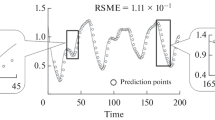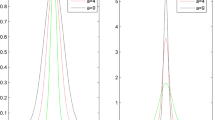Abstract
In this article, annealing robust radial basis function networks (ARRBFNs), which consist of a radial basis function network and a support vector regression (SVR), and an annealing robust learning algorithm (ARLA) are proposed for the prediction of chaotic time series with outliers. In order to overcome the initial structural problems of the proposed neural networks, the SVR is utilized to determine the number of hidden nodes, the initial parameters of the kernel, and the initial weights for the proposed ARRBFNs. Then the ARLA that can conquer the outliers is applied to tune the parameters of the kernel and the weights in the proposed ARRBFNs under the initial structure with SVR. The simulation results of Mackey-Glass time series show that the proposed approach with different SVRs can cope with outliers and give a fast learning speed. The results of the simulation are also given to demonstrate the validity of proposed method for chaotic time series with outliers.
Similar content being viewed by others
Explore related subjects
Discover the latest articles, news and stories from top researchers in related subjects.References
Gu H, Wang H (2007) Fuzzy prediction of chaotic time series based on singular value decomposition. Appl Math Comput 185:1171–1185
Zhang W, Wu ZM, Yang GK (2005) Genetic programming modeling on chaotic time series. Acta Electron Sinica 33(4):748–751
Harpham C, Dawson CW (2006) The effect of different basis functions on a radial basis function network for time series prediction: a comparative study. Neurocomputing 69:2161–2170
Chuang CC, Su SF, Hsiao CC (2000) The annealing robust backpropagation (BP) learning algorithm. IEEE Trans Neural Networks 11(5):1067–1077
Vapnik V (1995) The nature of statistical learning theory. Springer, Berlin
Jeng JT (2006) Hybrid approach of selecting hyper-parameters of support vector machine for regression. IEEE Trans Syst Man Cybern B36:699–709
Smola AJ, Schölkopf B (1998) From regularization operators to support vector kernels. Neural Inf Process Syst 10:343–349
Schölkopf B, Smola AJ, Williamson RC, Bartlett PL (2000) New support vector algorithms. Neur Comput 12:1207–1245
Author information
Authors and Affiliations
Corresponding author
Additional information
This work was presented in part at the 14th International Symposium on Artificial Life and Robotics, Oita, Japan, February 5–7, 2009
About this article
Cite this article
Fu, YY., Wu, CJ., Ko, CN. et al. ARRBFNs with SVR for prediction of chaotic time series with outliers. Artif Life Robotics 14, 29–33 (2009). https://doi.org/10.1007/s10015-009-0710-1
Received:
Accepted:
Published:
Issue Date:
DOI: https://doi.org/10.1007/s10015-009-0710-1




